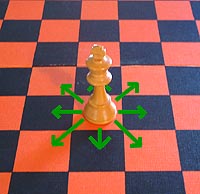When you play chess, each player takes it in turn to move ONE piece at a time. Here we shall learn the RULES of moving each piece. Each piece has a specific way it can move and interact with other pieces. We shall start from the top - The King.
Surprisingly, the King is one of the easiest pieces to learn to use - since he does very little! - its too dangerous for him really - if he's killed - you lose..chess is all about PROTECTING your king, not moving him or using him to attack!! However, when push comes to shove, and you find yourself in a situation where you do need to move or attack with the King (usually as a retreat or last resort)...
The King can move: ONE Square only, in ANY direction (forward, back, side, diagonal) - so long as its not already occupied.
If there is another piece already occupying that square...then the King may chose to 'kill' that piece and take its place (whereby you'd remove that piece from the game - note: you can not kill your own pieces).
For example: the King (shown in black just moving to square F7) could kill the knight (horse shown in white on square G7) if it chose to move onto the square to its right on the next go!
And last note on the King. If your King is in danger of being killed by a piece on the next move - your opponent must say "CHECK" to alert you. This means you must get your King to safety on your go (and cannot finish off any other moves you were thinking of making - which would be pointless anyhow if your King dies). So - remember - if you hear your opponent tell you "Check" - then check you King and stop any other plans you had - get your King to safety (i.e. by Killing the attacking piece, blocking it's line of attack with another piece or moving your King out of the way)!
PRACTICE*: only using the King - ask your opponent to use any pieces they wish. Your aim is to stay alive for as long as possible! See if you can beat your record.
(you will learn much later how to set up the pieces correctly on a chess board - as every piece has its rightful starting position. For these practice games - use what is called "scatter starts" - where you literally lay down your pieces at random on the chess board and play from there. This will give you numerous possible starting positions so you never get bored of practicing! - the only exception should be that you do not put the King in check during setup)
Surprisingly, the King is one of the easiest pieces to learn to use - since he does very little! - its too dangerous for him really - if he's killed - you lose..chess is all about PROTECTING your king, not moving him or using him to attack!! However, when push comes to shove, and you find yourself in a situation where you do need to move or attack with the King (usually as a retreat or last resort)...
The King can move: ONE Square only, in ANY direction (forward, back, side, diagonal) - so long as its not already occupied.
If there is another piece already occupying that square...then the King may chose to 'kill' that piece and take its place (whereby you'd remove that piece from the game - note: you can not kill your own pieces).
And last note on the King. If your King is in danger of being killed by a piece on the next move - your opponent must say "CHECK" to alert you. This means you must get your King to safety on your go (and cannot finish off any other moves you were thinking of making - which would be pointless anyhow if your King dies). So - remember - if you hear your opponent tell you "Check" - then check you King and stop any other plans you had - get your King to safety (i.e. by Killing the attacking piece, blocking it's line of attack with another piece or moving your King out of the way)!
PRACTICE*: only using the King - ask your opponent to use any pieces they wish. Your aim is to stay alive for as long as possible! See if you can beat your record.
(you will learn much later how to set up the pieces correctly on a chess board - as every piece has its rightful starting position. For these practice games - use what is called "scatter starts" - where you literally lay down your pieces at random on the chess board and play from there. This will give you numerous possible starting positions so you never get bored of practicing! - the only exception should be that you do not put the King in check during setup)



No comments:
Post a Comment